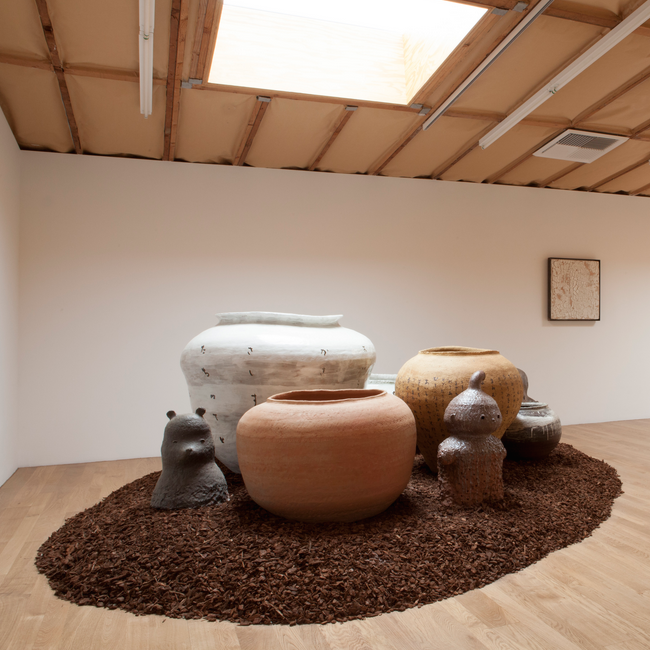A trio of forward-looking Japanese ceramists, Kazunori Hamana, Yuji Ueda and Otani Workshop, are on display at Blum and Poe (Los Angeles, September 11 — October 24, 2015). Organized by the artist Takashi Murakami, an avid ceramics collector, the show draws on the storied tradition of Japanese ceramics while the artists push it forward through inventive techniques with shaping, glazing, coloring and firing.
The gallery states that the show focuses on the “tools” of a tea ceremony— teacups, kettles, utensils, etc. These symbolize hierarchy and respect, becoming symbols of society. Ceramics have remained a pillar of Japanese heritage for centuries. Though this is a jumping off point for the exhibition, the artists explore a variety of forms, including large-scale vessels and Workshop’s soft pop sculptures. The gallery states of the show:

Kazunori Hamana, Untitled, 2015, ceramic, 16 1/2 x 27 x 24 1/2 inches
For this exhibition, Takashi Murakami brings together a new generation of Japanese ceramicists whose unique pottery methods merge a respect for lineage with improvisation, experimentation, and refinement. The work of all three artists — Hamana, Ueda, and Otani — is informed by lifestyle, the love of nature, working in remote surroundings, and sometimes farming their own land. Although these artists are young in age, they are accomplished craftsmen and have been forming, firing, and exhibiting their earthenware in Japan for several years. Many of the works in the exhibition have never been seen before in the United States, as this display of ceramics is an illumination of age-old traditions being expanded into the 21st century.

Kazunori Hamana, Untitled, 2015, ceramic, 19 x 27 1/2 x 23 1/2 inches
Kazunori Hamana makes ceramics on the pacific coast, in Chiba, Japan. The work is both stark and full of personality, oftentimes the surfaces are striped or imbued with designs or language. Urns, bowls, vessels, cups, and plates — each irregularly shaped by not only the vast history of the ceramic arts, but also by the characteristics found in the coastal environment where he works.
Yuji Ueda comes from a family of award-winning tea farmers in the Shiga Prefecture town of Shigaraki. His experimental approach to glazing and firing leads to a variety of distinct forms and vessels. Working both in intimate sizes and larger scales, Ueda’s alien surfaces and fragile textures are both tolerant and unyielding.

Otani Workshop is also based in Shigaraki — one of the great centers of Japanese ceramics for the last 800 years. In addition to clay, Otani works with wood, iron, and other materials. His small jars, vases, and other sculptural forms depicting figures and faces are characteristic of the many styles and motifs found throughout Japanese culture.
Love contemporary ceramic art + design? Let us know in the comments.








Hi ,
I absolutely love this artist.
I am looking to purchase a white ceramic pottery from kazunori hamana. Please let me know if you have anything.
Thank you in advance .
absolutely incredible! I am so moved by this work! Thanks for sharing.